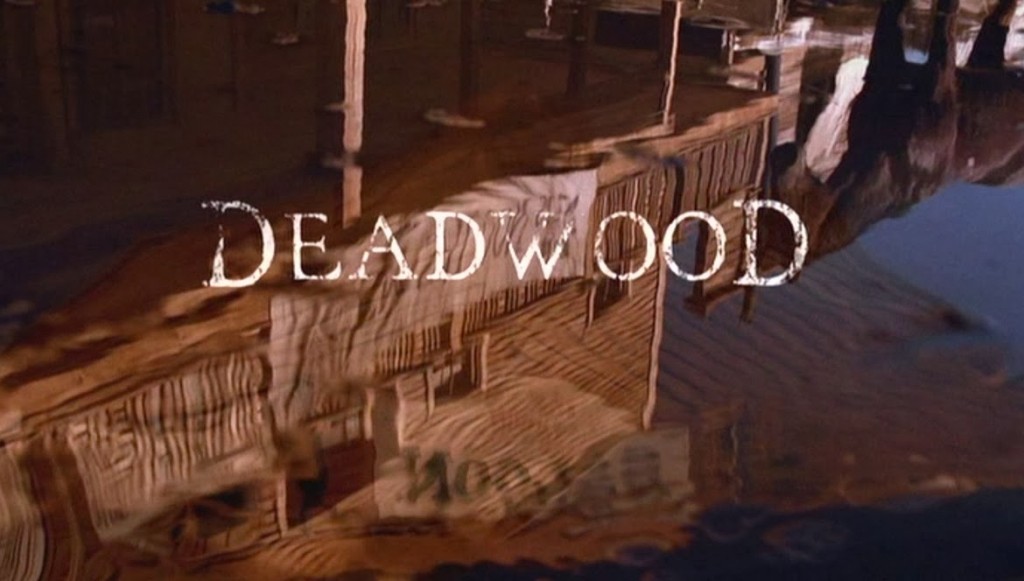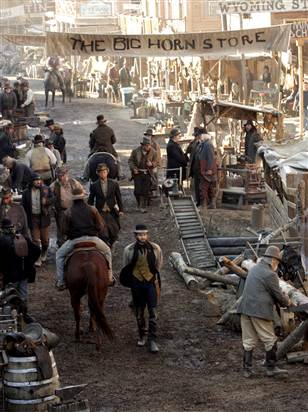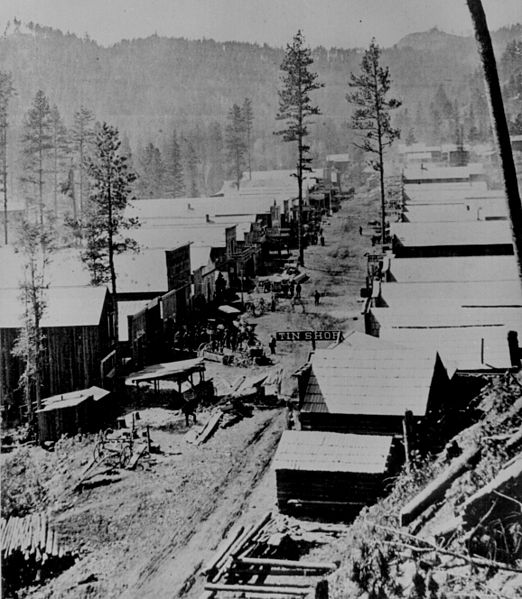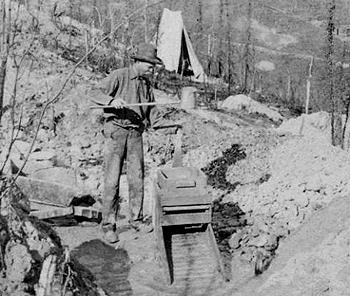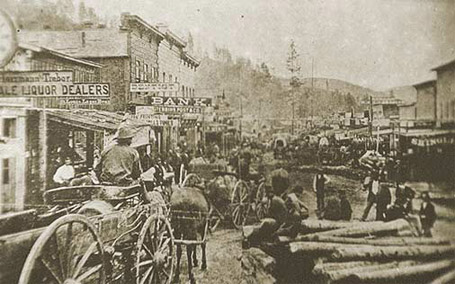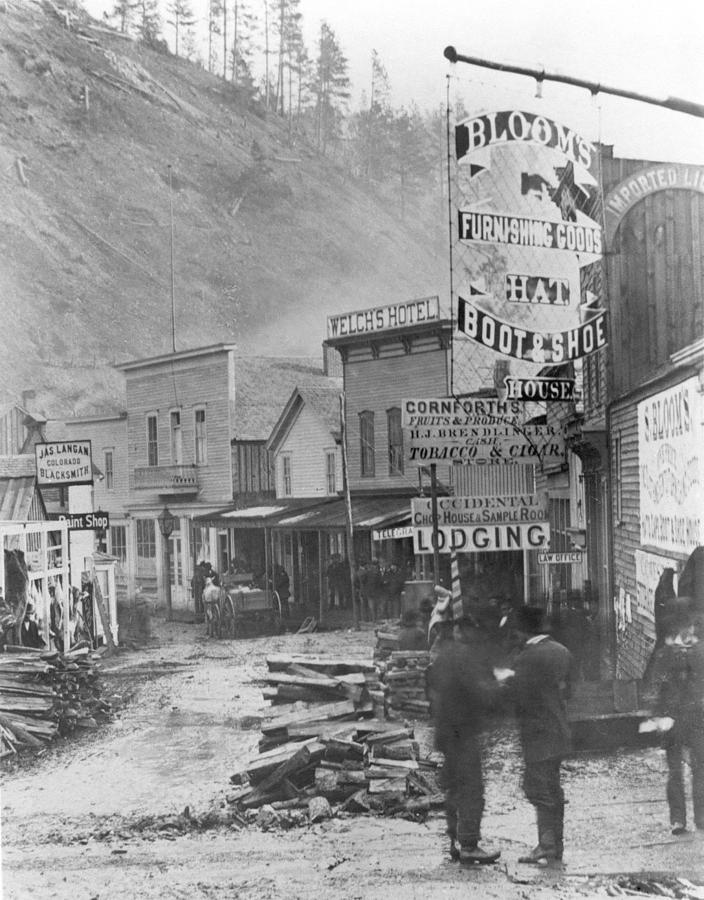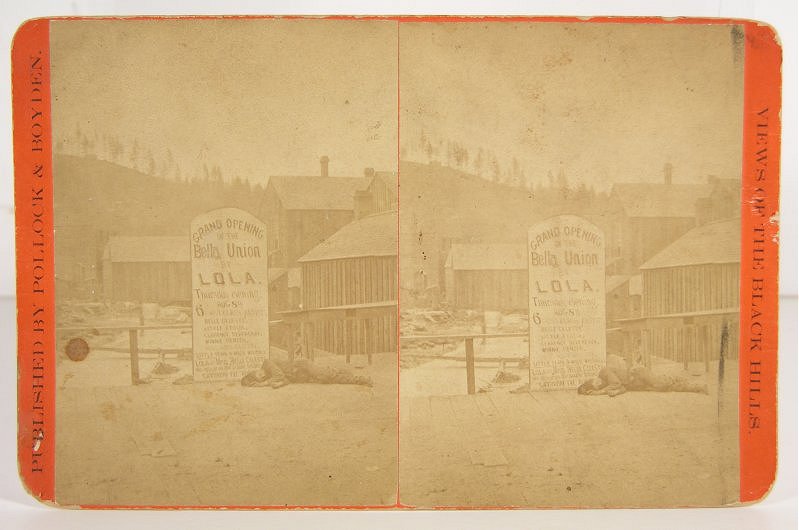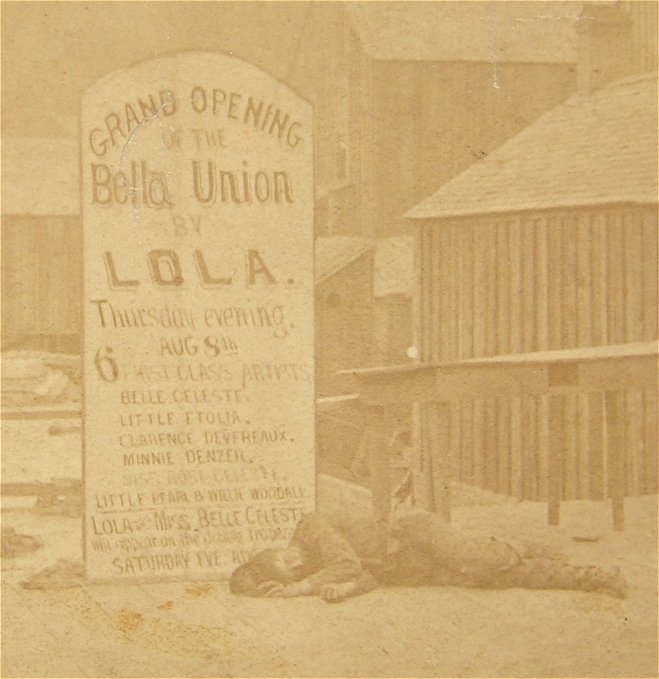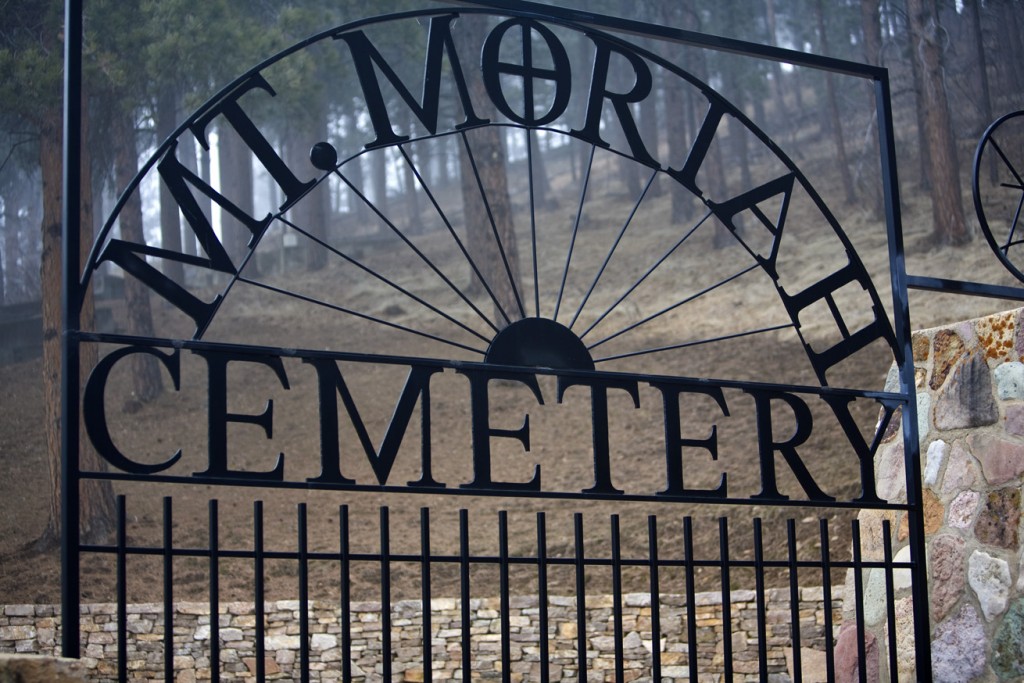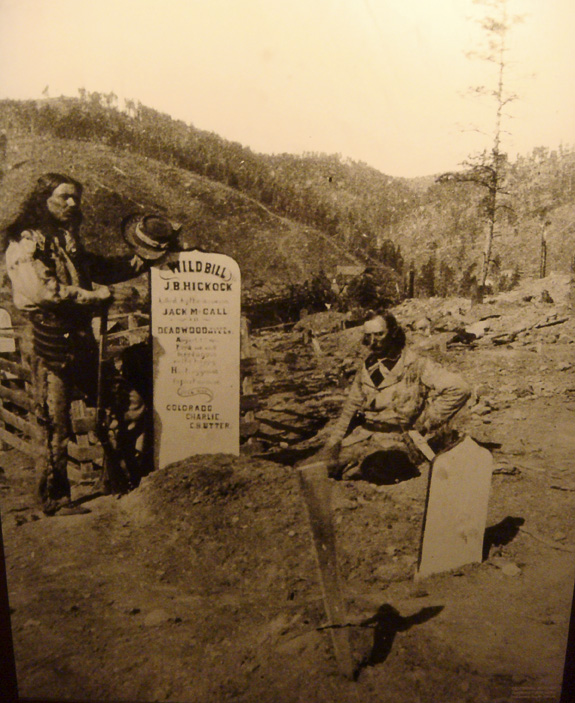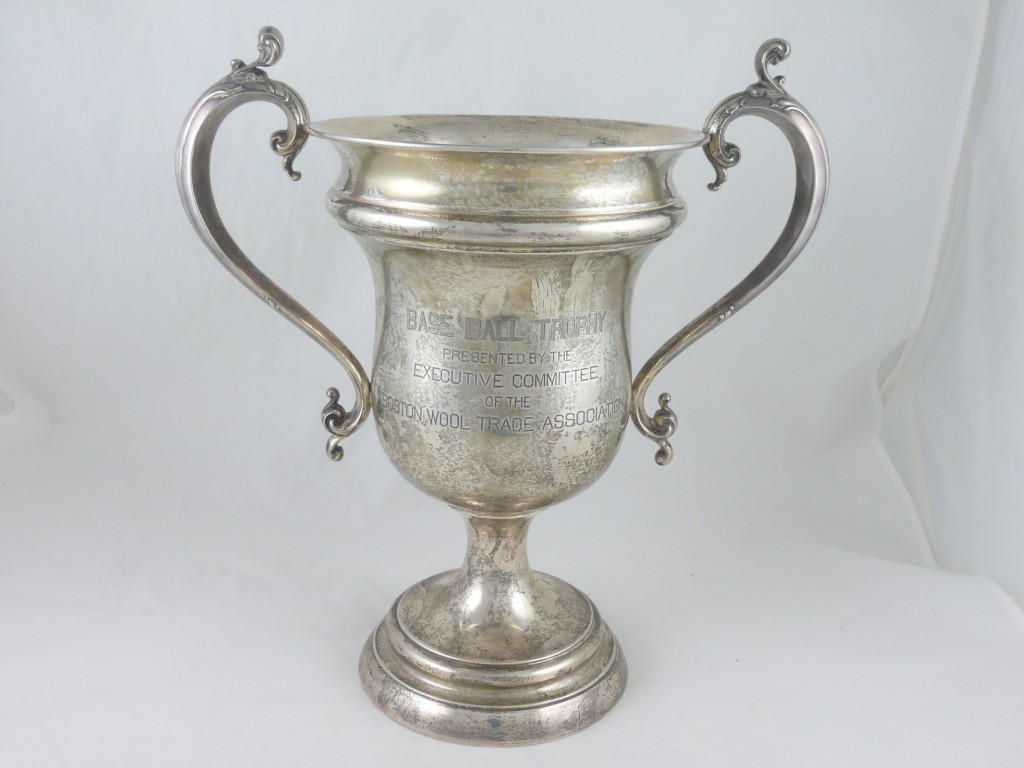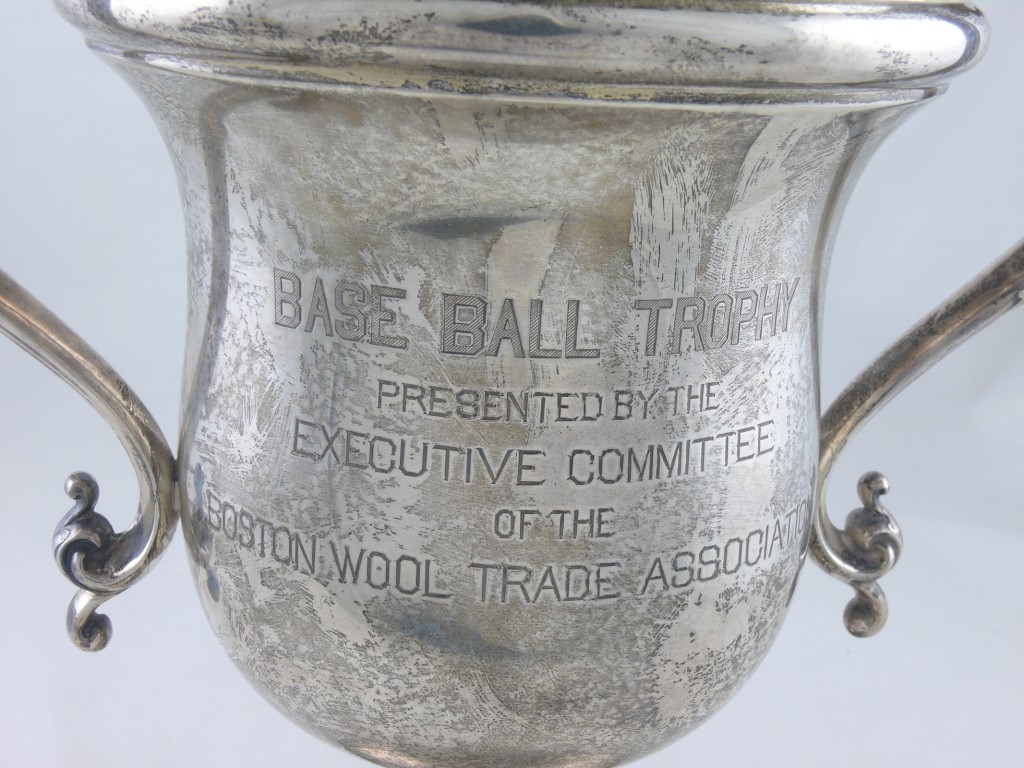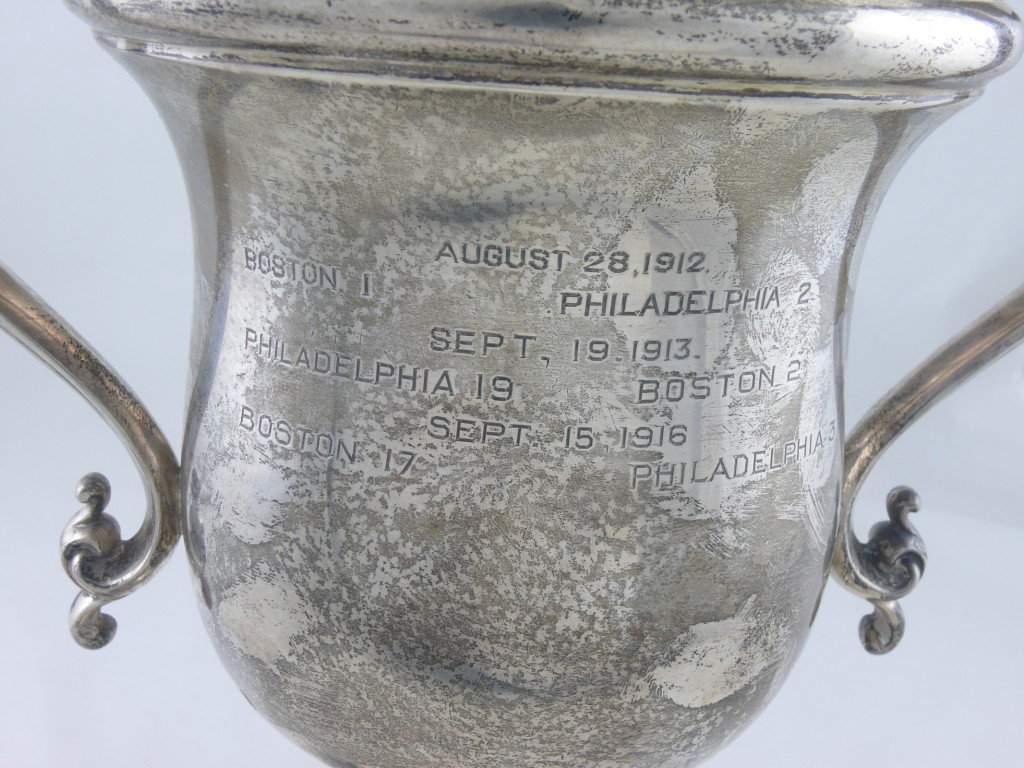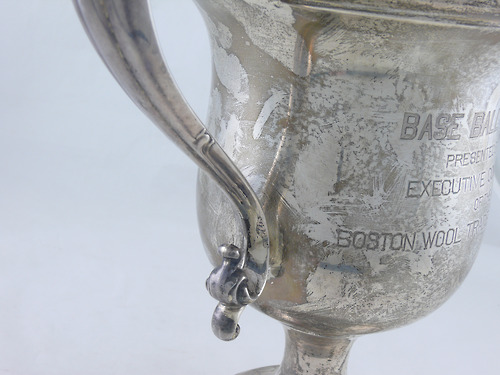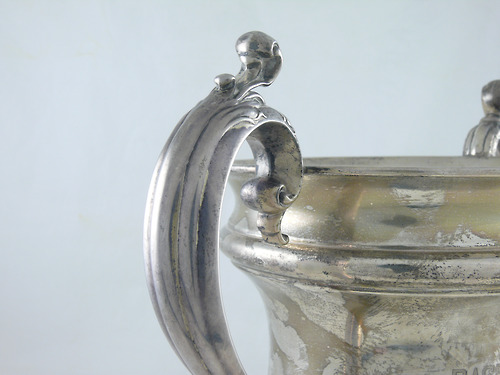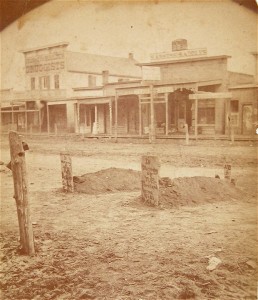 Our favorite Cabinet Card Photo of all time. The only identification is a manuscript notation that reads “B. F. Bickel / Larned Kansas / 1882″. We knew there was a story here that needed to be told and after weeks of research we discovered that the story was a WONDERFUL one – a true tale of the American West and better than any fiction ever written about that time and place!!
Our favorite Cabinet Card Photo of all time. The only identification is a manuscript notation that reads “B. F. Bickel / Larned Kansas / 1882″. We knew there was a story here that needed to be told and after weeks of research we discovered that the story was a WONDERFUL one – a true tale of the American West and better than any fiction ever written about that time and place!!
The Photograph depicts a scene on Broadway – the main street of Larned, Kansas – in the background we see a row of store fronts with a raised, wooden sidewalk. We can see signs for a Druggist, a Harness Shop and a barber shop. The street is, obviously, unpaved and we can see wood hitching post in front of the stores and one in the foreground of the Photo.
It appears that some type of macabre joke was staged on Broadway in Larned – there are two “graves” in the foreground, complete with boots protruding from the dirt and hats respectfully laid atop the mounds of earth. There are easily readable, hand lettered wood Tombstones marking the “graves”. One reads “In Memory of N. B. Freeland, Vene (sic) Vidi Vici”, the other “Chronoscope / In Memory of R. H. Ballinger Sic Semper Tyrannis”.
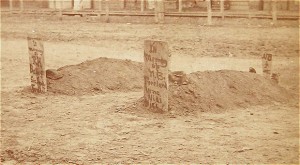
We purchased this amazing Western Americana Image without having the slightest idea what was going on here – it looked like the “Boot Hill Cemetery” had moved to the main street of Larned!! Some extensive and detailed internet research and some help from the folks at the Santa Fe Trail Center at Larned, Kansas finally uncovered the “tale of the Old West” that culminated in the scene depicted in this Photograph.
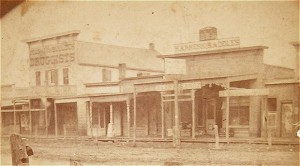
We were able to discover that both Freeland and Ballinger were very prominent Pioneer Citizens of Larned. Freeland was an Attorney and Ballinger (also an attorney) owned and edited the local “Chronoscope” Newspaper – a decidedly Republican Party leaning publication. Ballinger had studied Law in the office of Abraham Lincoln and was known to claim that he was the first to recognize Lincoln’s potential as a political candidate. Both Freeland and Ballinger served honorably during the Civil War – Freeland from 1861 to 1866 as a private in the 28th Illinois Volunteer Infantry seeing many battles and Ballinger from 1861 to 1864 first in the 3rd Illinois Cavalry and later as a Colonel of the Third Mississippi Colored Regiment (who saw duty mostly as a “Home Guard” Regiment).
Try as we could, however, we could not uncover the circumstances that led to the “burial” of these two prominent citizens on the main street in a scene right out of Tombstone or Deadwood!! A letter of inquiry to Dan Grzesiak, the Curator of the Santa Fe Trail Center in Larned, Kansas and his kindness finally uncovered just what was going on here. We have appended some early newspaper stories about the incident to this post (see below) but will summarize the events here. It is a story that could only happen in the American West of the 19th century and stands front and center as an example of the “character” and “characters” that have formed our perception of what life in the early West was all about.
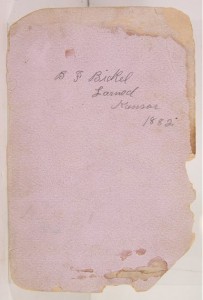
It seems that in 1882 Mr. Ballinger and Mr. Freeland had some type of disagreement. One account says it was over payment of a Bill and another account (a more likely scenario) states that Mr. Ballinger published something in the Chronoscope that offended the sensibilities of Mr. Freeland. In either case the two men confronted each other on the muddy main street of Larned and engaged in a rather comedic “fight” that was described as follows:
“Ballinger struck out at Freeland, when a running fight ensued which lasted five or ten minutes, both combatants finally tumbling into the gutter in front of George Leasure’s confectionery stand, where they wallowed in about three inches of mud and water until they were parted. It is said that they fought two rounds, Freeland scoring one on the first round by downing Ballinger, and Ballinger scoring one on the second by downing Freeland. When parted both were panting and puffing like mad bulls, were thickly plastered with mud and presented a most ridiculous aspect from the fact that neither sustained the least injury, not a scar or a scratch being visible upon either of their persons. Those who witnessed the affray say they fought like a couple of old women, and that the encounter from beginning to end was too utterly ridiculous for anything.”
The townsfolk could not let the two “prominent” citizens escape with their dignity and there ensued a “pageant” which was thoroughly enjoyed by all (well at least by most). On the evening of the fight a “mock” memorial service and funeral were held in front of the mud puddle where the two men “fought” and “died”. The store fronts were draped in black and eulogies were given to the delight of the many attendees. After some shared libations and a rasher of good natured ridicule, the crowd dispersed for the night – a good time was had by all!!

Those rising early the next morning found the site of the “fight” decorated as it is seen in the Photograph offered here. You will note that the streets are empty of horse or human and the Photo was surely taken in the very early morning hours. Another Newspaper story tells of the events of that morning:
“Two graves were fashioned from this dirt in front of the grocery where they controversy had occurred. And the jokers had Freeland and Ballinger die with their boots on for from each grave protruded a pair of boots. At the heads of the graves were boards that bore suitable inscriptions. The board at the head of Mr. Freeland’s grave carried unreadable Latin phrases for Freeland was quite an orator and would often display his knowledge of the dead language.
The perpetrators of the joke gathered early the next morning to witness the effect upon the principals of viewing their own graves. To Mr. Freeland, who arrived on the scene first, the affair was a laughable travesty but to Mr. Ballinger it was a deplorable tragedy and he immediately proceeded to remove the signboard from his grave.”
A special Thank You to Dan Grzesiak, the Curator of the Santa Fe Trail Center in Larned, Kansas for the following excerpts from local Newspapers regarding the events depicted in the Photograph:
Thursday, July 1, 1909;
An Early day Episode
When Two Prominent Citizens Were “Buried” on Broadway.
Whenever several old settlers of Pawnee County are together and get to reviewing old times, one of the remarks sure to be made sooner or later is “Were you here that time they buried Ballinger and Freeland on Broadway?” And the laugh which always follows shows it was one of the notable frolics of those early years before people were burdened with enormous wheatcrops and bank accounts, and found time for a little “liveliness” as they “walked by the way.”Councilman A. W. Swan was looking over some old clippings last week and among those carefully preserved was one from the Larned Eagle-Optic of some twenty-five or thirty years ago, giving a description of the incident of the “burial” and the events which led up to it. The article is written in a seriocomic vein and is unsigned but Net Adams has always been credited with writing the piece, and so far as we know has never even attempted to prove an alibi. We produce the article in full for the benefit of our readers:
A TRAGEDY IN THREE ACTS.
ACT I
The difficulty between N. B. Freeland, Esq., and R. H. Ballinger, editor of the Chronoscope, culminated Tuesday in an attack upon the former by the latter and subsequently a burlesque funeral and burial on Broadway. The parties met in front of Lee Ainsworth’s meat market, and after a short conversation concerning a bill, Ballinger struck out at Freeland, when a running fight ensued which lasted five or ten minutes, both combatants finally tumbling into the gutter in front of George Leasure’s confectionery stand, where they wallowed in about three inches of mud and water until they were parted. It is said that they fought two rounds, Freeland scoring one on the first round by downing Ballinger, and Ballinger scoring one on the second by downing Freeland. When parted both were panting and puffing like mad bulls, were thickly plastered with mud and presented a most ridiculous aspect from the fact that neither sustained the least injury, not a scar or a scratch being visible upon either of their persons. Those who witnessed the affray say they fought like a couple of old women, and that the encounter from beginning to end was too utterly ridiculous for anything.
ACT II
The second act opened about three hours later on the scene of the battleground. A long sign-board which read: “Last remains of Ballinger and Freeland – Rest in Peace,” was erected over the mud hole where the heroes fell, black drapery was hung promiscuously over the hitching posts, awning poles, etc., and a general air of gloom and sadness pervaded the scene. The spot was visited by a large number of our citizens, and remarks of sympathy for the dead and condolence for the surviving members of the warriors’ families were general and heartfelt. The scene called up reminiscences. Friends gathered in little knots to tell how valiantly Ballinger had fought during the war as colonel of the colored home guards of Illinois – that gallant little band which stayed at home to take care of the women while all the men were away fighting the rebels – what daring raids he made upon hen-roosts and pig-stys, scouring the country sometimes as much as two or three miles from town, and striking terror to the hearts of turkey-gobblers and bantam roosters – how many bloody battles he would have been in had he ever been ordered to the front to fight and couldn’t by any possible means have escaped the call – and finally to express their regret that he at last “died with his boots on.” Of Freeland it was said that he served during the same war as high private in the front rank, fought gallantly and bravely for the country which boasts with pride of the “Star Spangled Banner,” and the spread-eagle of freedom, that from exposure he contracted disease which sent him home at the close of the war an invalid for life, only to be ruthlessly murdered by a fellow comrade, but to his honor it was said that he also “died with his boots on,” fighting with his face to the foe. When night gathered her sable robes of darkness over the scene, a hush fell upon the multitude. They were in the presence of death. The occasion was a doleful one. The funeral services were about to begin. Torches were brought forth draped in mourning, and their fitful light cast a lurid glare over the sacred mud-hole, cutting sharp, black shadowy lines here and there, and otherwise increasing the mournful solemnity of the scene. Flags which both fought so gallantly to carry with “Sherman to the Sea,” (Ballinger did his fighting in Illinois to keep down the bantam roosters) were hung at halfmast. An empty dry goods box was confiscated to do service as a rostrum, a funeral sermon preached, the brass band played a couple of doleful pieces, the friends of the deceased weeped a few bucketfuls of tears into the mudhole, and the congregation sadly dispersed to their several homes, to dream about the fearful tragedy and see ghosts stalking over their bed-clothes and straddling the foot and head-boards until morning.
ACT III
Wednesday morning dawned clear and bright. Not a cloud obscured the horizon. Silence reigned supreme. The scene again opened upon the sanguine battleground of the day before. Devoted friends had been at work during the night – presumable the Hyperions. Two neatly constructed mounds of earth marked the last resting place of the dead. Broadway had the appearance of “Boot Heel Cemetery.” It is said that the warriors were buried where they fell because the pieces of the mingled remains were not large enough to remove. The two graves were made side by side, and it is supposed that the corpses were shoveled in and buried without much regard to ceremony. The foot board of one of the graves bore the initials “R. H. B.,” and the head-board was inscribed on one side, “R. H. Ballinger. Died with boots on.” On the other side, “Chronoscope. In Memory of R. H. Ballinger. Sic Semper Tyrannis” – (may this ever be the fate of tyrants.) On the foot-board of the other grave were the initials, “N. B.” and a little “f,” one of the boys who had a musical education claiming that the victim died B flat. On one side of the head-board was inscribed, “In Memory of N. B. Freeland, Pro Bono Publico” – (for the public good.) On the other side, “In Memory of N. B. Freeland. Veni, Vini, Vici,” (I came, I saw, I conquered.) The toes of a couple of boots stuck out at the foot of each grave, indication that as they died so they were buried, “with their boots on,” also that they had been interred face-upwards, in a civilized manner. Empty beer bottles were arranged around the head of Ballinger’s grave, emblems, probably, of his “weakness” while a cumberer of this earth, and for the further purpose of lending an additional charm to the surroundings. Early visitors were struck by the picturesque scene and were moved to tears. Streams of people visited the new graves, read the inscriptions and dropped a tear for the departed. Later in the day, however, some ruthless hand pulled up the head-boards, kicked over the beer bottles, and otherwise desecrated the graves, and today the busy traffic on Broadway passes to and fro over the sacred spots, the dead are forgotten, and the tragic scene of blood and carnage is fast fading out of the minds of our people. Such is life. Requiescat in pace.
…………………
The Tiller & Toiler
Friday, October 13, 1916
This Was Long Ago In Larned
A picture of two graves in the streets of Larned was found recently in Mylon, Utah, and mailed by the commercial club of that city to E. E. Frizell. It was after N. B. Freeland and R. H. Ballinger, two early day citizens quarreled and threatened each other in very expressive language and then failed to make good on their threats, that a bunch of local wags constructed the two graves in the street, a very grave sort of joke, indeed. That was long and long ago. It is said that a traveling man in town that day asked about the graves and was told that the dead were usually planted in such fashion until enough bodies had accumulated to warrant carting them to the cemetery and interring them in the proper manner. The traveling man left for other parts hurriedly, it is said. Several pictures of the two graves are owned in Larned, and Comrade Smith has the original plate.
……………..
The Tiller and Toiler
Thursday, June 15, 1922
The old talk of the two empty graves in Larned’s Broadway is a familiar one but oft repeating has not detracted from the interest. Prosecution and care were hot on the heels of newspaper editors then as well as now, for when Dick Ballinger, who edited the Chronoscope at the time, saw fit to get personal in his sheet, Mr. Freeland, the object of the remarks, strenuously objected. He accosted Ballinger the day after publication of the article. His ire was roused and his fists clenched. But Ballinger was unafraid. For a while they sparred but brotherly affections seemed to gain the upper hand and nobody got hurt.
Practical jokers were alive at that date and so it came to pass that Charley Valk, drayman, was engaged to supply two loads of fresh dirt for the miscreants. Two graves were fashioned from this dirt in front of the grocery where they controversy had occurred. And the jokers had Freeland and Ballinger die with their boots on for from each grave protruded a pair of boots. At the heads of the graves were boards that bore suitable inscriptions. The board at the head of Mr. Freeland’s grave carried unreadable Latin phrases for Freeland was quite an orator and would often display his knowledge of the dead language. The perpetrators of the joke gathered early the next morning to witness the effect upon the principals of viewing their own graves. To Mr. Freeland, who arrived on the scene first, the affair was a laughable travesty but to Mr. Ballinger it was a deplorable tragedy and he immediately proceeded to remove the signboard from his grave.
…………………
 Lot of (34) very rare and fantastic, original 1884-5 Manuscript Letters written by Mrs. Minnie Hamilton Whitman from Bogota, Columbia while living there with her husband, Bernard Whitman who at the time was the chief engineer building Columbia’s first Railroad Line – the “Bogotá Savannah Railway”. Bernard Whitman died in Bogata, Columbia in late 1885. These Letters, sent to her mother in the United States give a simply amazing insight into life in the Republic of Columbia for an American family with young children as well as a treasure trove of information about the people, the natural history, the customs, the politics and life in general in and around the Capital City of Columbia.
Lot of (34) very rare and fantastic, original 1884-5 Manuscript Letters written by Mrs. Minnie Hamilton Whitman from Bogota, Columbia while living there with her husband, Bernard Whitman who at the time was the chief engineer building Columbia’s first Railroad Line – the “Bogotá Savannah Railway”. Bernard Whitman died in Bogata, Columbia in late 1885. These Letters, sent to her mother in the United States give a simply amazing insight into life in the Republic of Columbia for an American family with young children as well as a treasure trove of information about the people, the natural history, the customs, the politics and life in general in and around the Capital City of Columbia.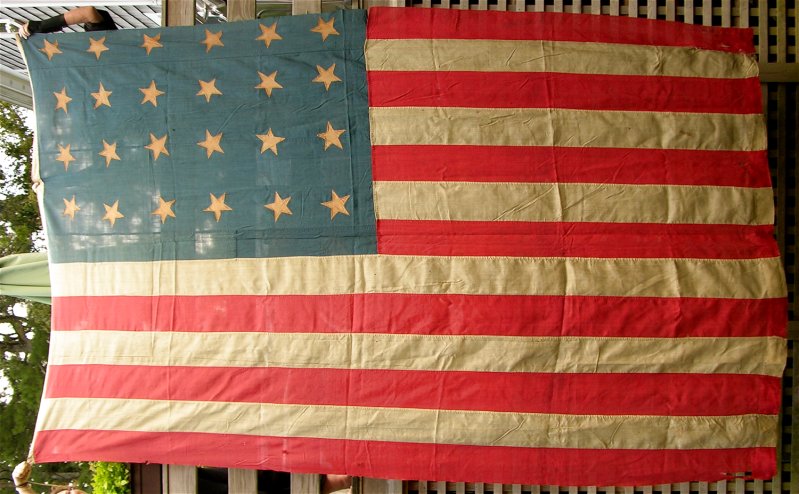
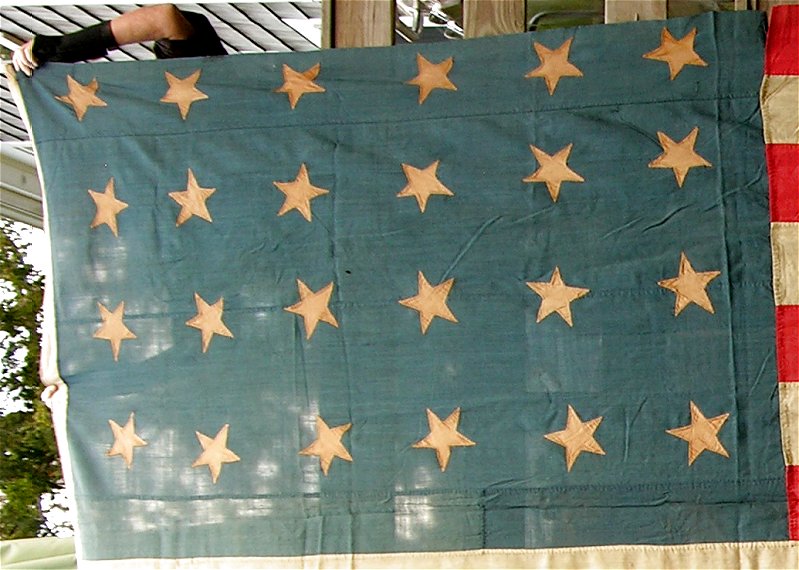
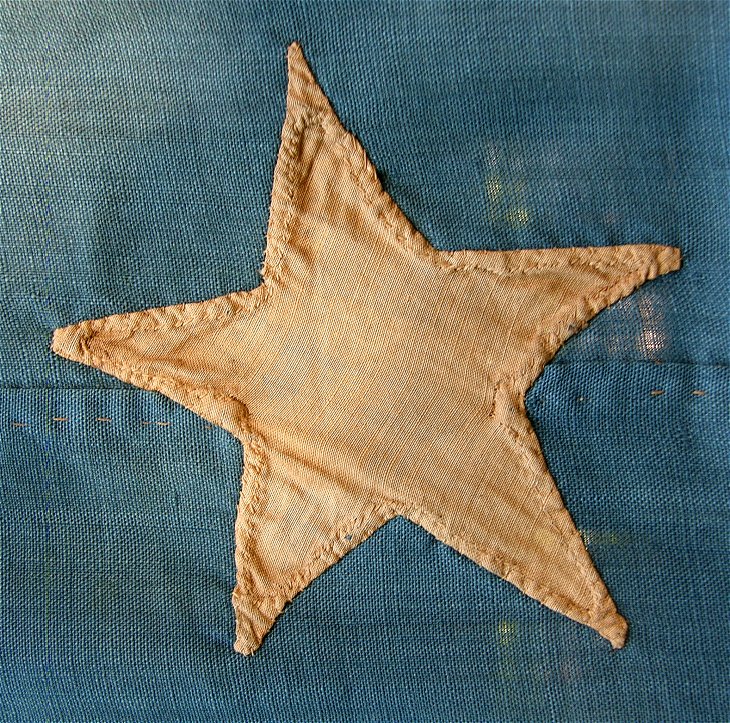
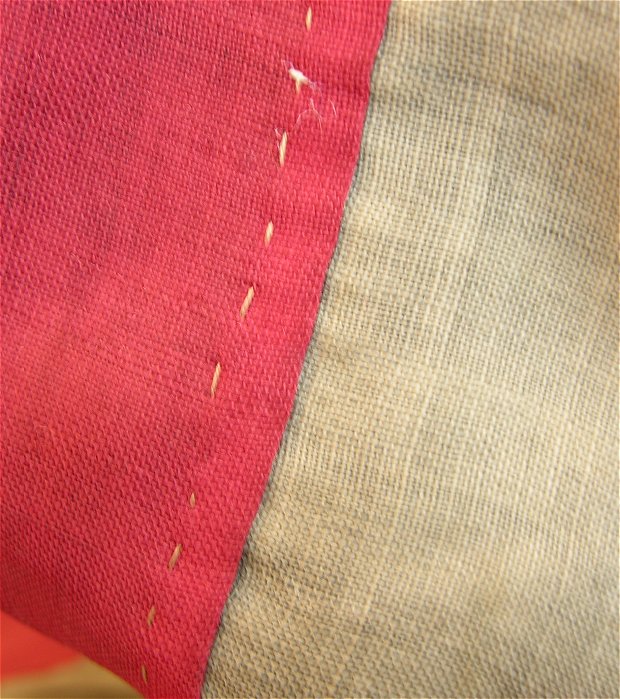
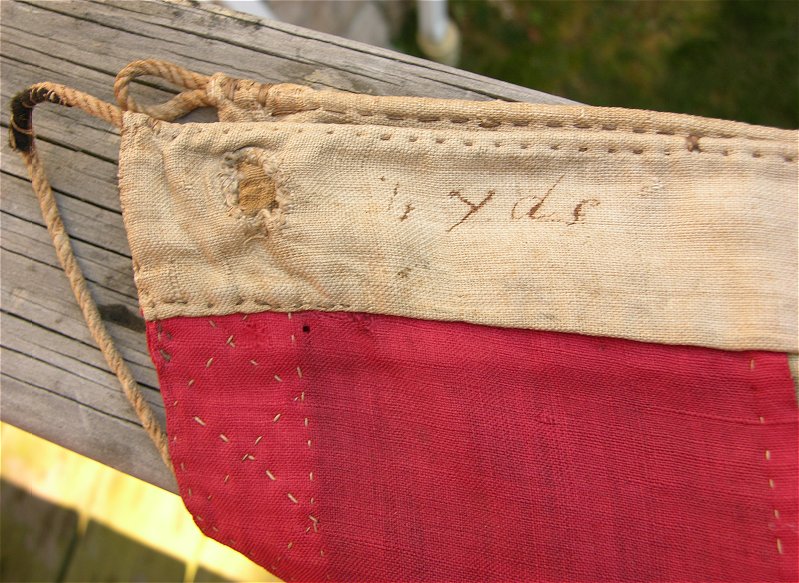

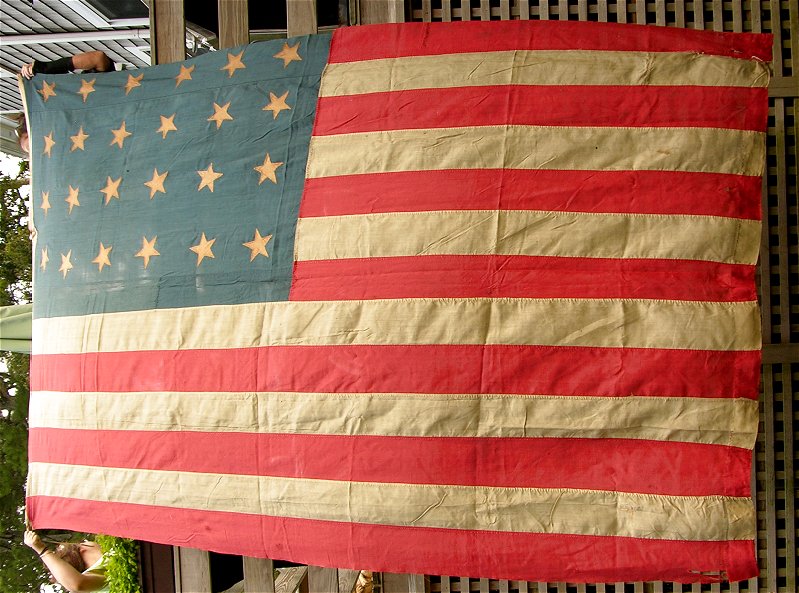
 Our favorite Cabinet Card Photo of all time. The only identification is a manuscript notation that reads “B. F. Bickel / Larned Kansas / 1882″. We knew there was a story here that needed to be told and after weeks of research we discovered that the story was a WONDERFUL one – a true tale of the American West and better than any fiction ever written about that time and place!!
Our favorite Cabinet Card Photo of all time. The only identification is a manuscript notation that reads “B. F. Bickel / Larned Kansas / 1882″. We knew there was a story here that needed to be told and after weeks of research we discovered that the story was a WONDERFUL one – a true tale of the American West and better than any fiction ever written about that time and place!!


